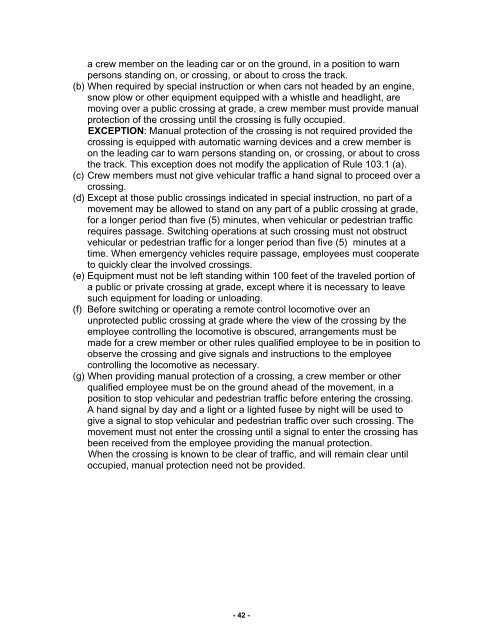Canadian Rail Operating Rules (CROR) TC O-0-93 - PDF
Canadian Rail Operating Rules (CROR) TC O-0-93 - PDF
Canadian Rail Operating Rules (CROR) TC O-0-93 - PDF
Create successful ePaper yourself
Turn your PDF publications into a flip-book with our unique Google optimized e-Paper software.
a crew member on the leading car or on the ground, in a position to warn<br />
persons standing on, or crossing, or about to cross the track.<br />
(b) When required by special instruction or when cars not headed by an engine,<br />
snow plow or other equipment equipped with a whistle and headlight, are<br />
moving over a public crossing at grade, a crew member must provide manual<br />
protection of the crossing until the crossing is fully occupied.<br />
EXCEPTION: Manual protection of the crossing is not required provided the<br />
crossing is equipped with automatic warning devices and a crew member is<br />
on the leading car to warn persons standing on, or crossing, or about to cross<br />
the track. This exception does not modify the application of Rule 103.1 (a).<br />
(c) Crew members must not give vehicular traffic a hand signal to proceed over a<br />
crossing.<br />
(d) Except at those public crossings indicated in special instruction, no part of a<br />
movement may be allowed to stand on any part of a public crossing at grade,<br />
for a longer period than five (5) minutes, when vehicular or pedestrian traffic<br />
requires passage. Switching operations at such crossing must not obstruct<br />
vehicular or pedestrian traffic for a longer period than five (5) minutes at a<br />
time. When emergency vehicles require passage, employees must cooperate<br />
to quickly clear the involved crossings.<br />
(e) Equipment must not be left standing within 100 feet of the traveled portion of<br />
a public or private crossing at grade, except where it is necessary to leave<br />
such equipment for loading or unloading.<br />
(f) Before switching or operating a remote control locomotive over an<br />
unprotected public crossing at grade where the view of the crossing by the<br />
employee controlling the locomotive is obscured, arrangements must be<br />
made for a crew member or other rules qualified employee to be in position to<br />
observe the crossing and give signals and instructions to the employee<br />
controlling the locomotive as necessary.<br />
(g) When providing manual protection of a crossing, a crew member or other<br />
qualified employee must be on the ground ahead of the movement, in a<br />
position to stop vehicular and pedestrian traffic before entering the crossing.<br />
A hand signal by day and a light or a lighted fusee by night will be used to<br />
give a signal to stop vehicular and pedestrian traffic over such crossing. The<br />
movement must not enter the crossing until a signal to enter the crossing has<br />
been received from the employee providing the manual protection.<br />
When the crossing is known to be clear of traffic, and will remain clear until<br />
occupied, manual protection need not be provided.<br />
-42-

















